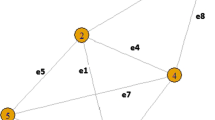Abstract
In this paper we consider the evaluation of the well known  -network unreliability parameter by means of a new RVR Monte-Carlo method. This method is based on series-parallel reductions and a partitioning procedure using pathsets and cutsets for recursively changing the original problem into similar ones on smaller networks. By means of several experimental results, we show that the proposed method has good performances in rare event cases and offers significant gains over other state-of-the-art variance reduction techniques.
-network unreliability parameter by means of a new RVR Monte-Carlo method. This method is based on series-parallel reductions and a partitioning procedure using pathsets and cutsets for recursively changing the original problem into similar ones on smaller networks. By means of several experimental results, we show that the proposed method has good performances in rare event cases and offers significant gains over other state-of-the-art variance reduction techniques.



Similar content being viewed by others
References
Ball, M. O. (1986). Computational complexity of network reliability analysis: an overview. IEEE Transactions on Reliability, R-35(3), 230–239.
Cancela, H., & El Khadiri, M. (1996). An improvement to the total hazard method for system reliability simulation. Probability in the Engineering and Informational Sciences, 10, 187–196.
Cancela, H., & El Khadiri, M. (1998). Series-parallel reductions in Monte-Carlo network reliability evaluation. IEEE Transactions on Reliability, 47(2), 159–164.
Cancela, H., & El Khadiri, M. (2003). The recursive variance reduction simulation algorithm for network reliability evaluation. IEEE Transactions on Reliability, 52(2), 207–212.
Cancela, H., El Khadiri, M., & Rubino, G. (2009). Rare events analysis by Monte Carlo techniques in static models. In G. Rubino & B. Tuffin (Eds.), Rare event simulation methods using Monte Carlo methods. New York: Wiley, Chap. 7.
Chang, M. K., & Satyanarayana, A. (1983). Network reliability and the factoring theorem. Networks, 13, 107–120.
Colbourn, C. J. (1987). The combinatorics of network reliability. New York: Oxford University Press.
Cormen, T. H., Leiserson, C. E., & Rivest, R. L. (1990). Introduction to algorithms. Cambridge: The MIT Press.
Easton, M. C., & Wong, C. K. (1980). Sequential destruction method for Monte Carlo evaluation of system reliability. IEEE Transactions on Reliability, R-29(1), 27–32.
Elperin, T., Gertsbakh, I., & Lomonosov, M. (1991). Estimation of network reliability using graph evolution models. IEEE Transactions on Reliability, 40(5), 572–581.
Fishman, G. S. (1986a). A comparison of four Monte-Carlo methods for estimating the probability of s-t connectedness. IEEE Transactions on Reliability, R-35(2), 145–155.
Fishman, G. S. (1986b). A Monte Carlo sampling plan for estimating network reliability. Operations Research, 34(4), 581–594.
Hui, K. P., Bean, N., Kraetzl, M., & Kroese, D. P. (2003). The tree cut and merge algorithm for estimation of network reliability. Probability in the Engineering and Informational Sciences, 17(1), 24–45.
Hui, K. P., Bean, N., Kraetzl, M., & Kroese, D. P. (2005). The cross-entropy method for network reliability estimation. Annals of Operations Research, 134, 101–118.
Jun, C. H., & Ross, S. M. (1992). System reliability by simulation: random hazards versus importance sampling. Probability in the Engineering and Informational Sciences, 6, 119–126.
Karp, R., & Luby, M. G. (1983). A new Monte Carlo method for estimating the failure probability of an n-component system. Computer Science Division, University of California (Berkley).
Kumamoto, H., Tanaka, K., Inoue, K., & Henley, E. J. (1980). Dagger-sampling Monte Carlo for system unavailability evaluation. IEEE Transactions on Reliability, R-29(2), 122–125.
Lomonosov, M. (1994). On Monte-Carlo estimates in network reliability. Probability in the Engineering and Informational Sciences, 8, 245–264.
Ross, S. M. (1990). Variance reduction in simulation via random hazards. Probability in the Engineering and Informational Sciences, 4, 199–309.
Ross, S. M. (1994). A new simulation estimator of system reliability. Journal of Applied Mathematics and Stochastic Analysis, 7(4), 331–336.
Satyanarayana, A., & Wood, R. K. (1985). A linear-time algorithm for computing k terminal in series-parallel networks. SIAM Journal on Computing, 14(4), 818–832.
Wood, K. (1985). A factoring algorithm using polygon-to-chain reductions for computing k-terminal network reliability. Networks, 15, 173–190.
Wood, K. (1986). Factoring algorithms for computing k-terminal network reliability. IEEE Transactions on Reliability, R-35(3), 269–278.
Acknowledgements
This work was partially supported by project 09STIC03, funded by the STIC-AMSUD cooperation program between South American countries and France.
Author information
Authors and Affiliations
Corresponding author
Rights and permissions
About this article
Cite this article
Cancela, H., El Khadiri, M. & Rubino, G. A new simulation method based on the RVR principle for the rare event network reliability problem. Ann Oper Res 196, 111–136 (2012). https://doi.org/10.1007/s10479-011-1017-x
Published:
Issue Date:
DOI: https://doi.org/10.1007/s10479-011-1017-x




